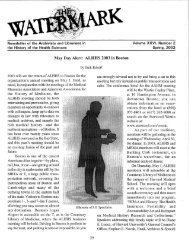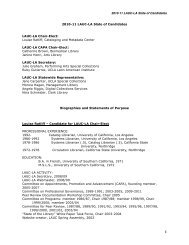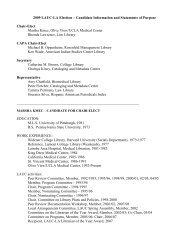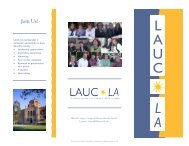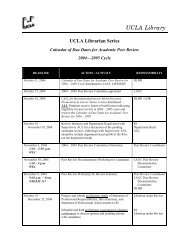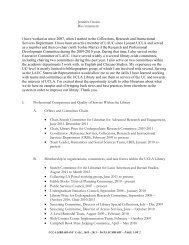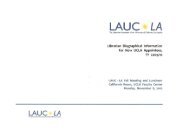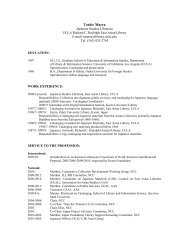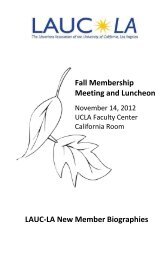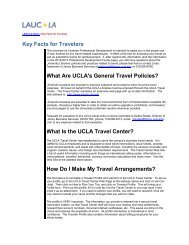Summer 2005 - UCLA
Summer 2005 - UCLA
Summer 2005 - UCLA
You also want an ePaper? Increase the reach of your titles
YUMPU automatically turns print PDFs into web optimized ePapers that Google loves.
Watermark, Vol. XXVIII, No. 3 (<strong>Summer</strong> <strong>2005</strong>)<br />
future features which include displaying the total number<br />
of hits per search (though retrieval still remains at<br />
1000), a journal title abbreviations list (yeah!), and the<br />
ability to sort searches. They also reported on a study<br />
that looks at the overlap, redundancy, or originality of<br />
the citations in Index Medicus as compared to those in<br />
Index Catalogue. The Bibliographic Services Division,<br />
which handles OldMedline, is working on including<br />
the Quarterly Cumulative Index Medicus.<br />
After a break, Steve Novak of Columbia University<br />
Medical Center and Nancy McCall of the Johns Hopkins<br />
Medical Institutions gave an update on HIPAA’s<br />
Privacy Rule as it affects patient records, photographs,<br />
medical research documents, etc. They had given testimony<br />
to the National Committee on Vital and Health<br />
Statistics, Subcommittee on Privacy and Confidentiality,<br />
January 11, <strong>2005</strong>, about the impact of the HIPAA<br />
Privacy Rule as it applied to access and utilization of<br />
archives. The common theme was that each institution<br />
seems to be accommodating HIPAA in its own way.<br />
Whether they are a covered entity or an uncovered entity<br />
impacts on how much attention they pay to allowing<br />
access to primary material. Novak and McCall reported<br />
that the Committee seemed interested in our<br />
position, but seemed relatively unaware that access to<br />
patient records, clinical material, etc., might impact<br />
historians, librarians, or researchers in general. The full<br />
testimony is available at .<br />
One of the particularly prickly items is access to photographic<br />
archives, especially in a hospital setting, as<br />
they are so often used in promotion and in historical<br />
renderings. Also, archives like those at Johns Hopkins<br />
are particularly frustrated by the bureaucratic requirements<br />
for registration for general reference services<br />
and the length of time it takes to screen the requested<br />
documents. The concern of archivists like Steve and<br />
Nancy is acute, as Steve so eloquently said: “All this<br />
leads me to fear that the primary documents needed to<br />
write the history of health care and the biomedical sciences<br />
in the United States may come to an end in the<br />
late 1990s. It would be paradoxical and unfortunate if a<br />
law that was designed in part to shed light on the workings<br />
of our health care systems makes it impossible for<br />
the scholars of the future to do just that.” The membership<br />
suggested that we make ourselves more vocal and<br />
visible in educating this Committee, perhaps even<br />
looking into permanently having an archivist on the<br />
Subcommittee.<br />
Our Immediate Past President, Jodi Koste, asked the<br />
membership to consider our organization and its future<br />
directions in an exercise called “Before We Turn 40:<br />
Ideas, Discussion, and Future Directions for ALHHS.”<br />
We broke up into small groups of about seven or eight,<br />
and had about fifteen minutes to brainstorm about what<br />
we thought the group should be attending to. The individual<br />
discussions were illuminating and provided<br />
much food for thought. Each table then sent a representative<br />
to the podium to summarize each group’s ideas.<br />
Many great minds thought of similar initiatives. Following<br />
is a list of areas and ideas mentioned. A more<br />
thorough rendering may appear in a future Watermark.<br />
1. More content of ALHHS related concerns and<br />
solutions on the Web site.<br />
2. More public relations, marketing, and soliciting<br />
of new members.<br />
3. Programmatic attention to the reality of capturing<br />
the electronic record in our institutions.<br />
4. Provide hands-on workshops at our annual<br />
meeting.<br />
5. Strengthen relationship with American Association<br />
for the History of Medicine (AAHM).<br />
6. Survey the membership about programs, needs, if<br />
we are meeting their needs, etc.<br />
7. Educate the broader professional world about<br />
what we do and why they need us.<br />
8. Continue HIPAA work.<br />
9. Consider a scholarship for new members to<br />
attend annual meeting.<br />
10. Become a vocal advocate for our collections,<br />
our specialty, our concerns with preservation,<br />
conservation, and access.<br />
There were many more nuances, all worth pursuing<br />
throughout the year and at our annual meetings.<br />
We broke for lunch and at the end of lunch, in the<br />
interest of time, Lilla began the Business Meeting.<br />
Business Meeting: Old Business<br />
The motion was passed to accept our 2004 minutes.<br />
Suzanne Porter gave the report on the elections for<br />
officers. After reviewing the dynamics of the election<br />
Suzanne announced the new President-Elect, Micaela<br />
Sullivan-Fowler, the new Secretary-Treasurer, Patricia<br />
Gallagher, and the two new Members-at-Large, Christine<br />
Ruggere and Russell Johnson.<br />
49




